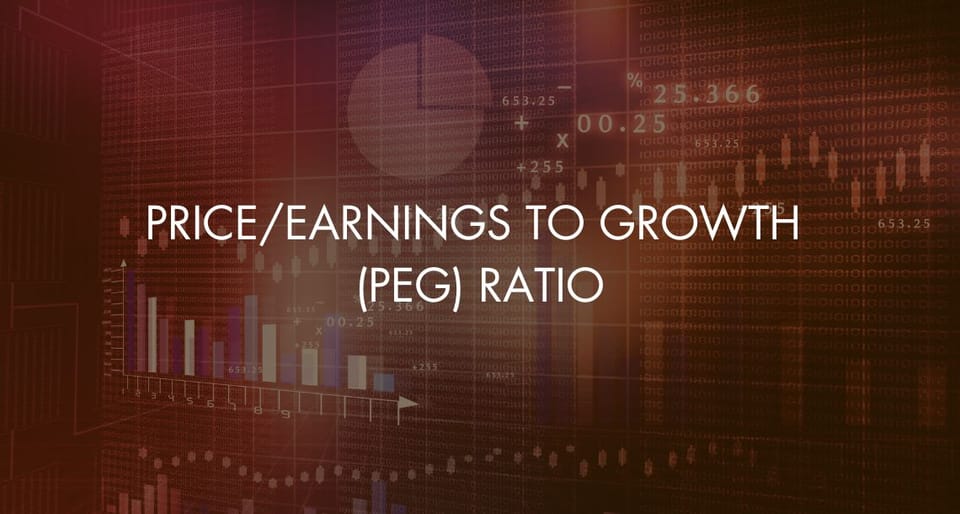Analyzing the Price/Earnings to Growth (PEG) Ratio: A Balanced View of Valuation

When evaluating stocks, the Price/Earnings to Growth (PEG) Ratio is a pivotal metric that extends beyond the traditional Price to Earnings (P/E) ratio by incorporating expected earnings growth into the equation. This ratio aims to provide a more balanced view of a company's valuation by considering both its current earnings and its future growth potential.
What is the PEG Ratio?
The PEG ratio is calculated by taking the P/E ratio of a company and dividing it by the growth rate of its earnings for a specific period:
This metric helps in determining whether a stock is undervalued or overvalued by factoring in growth expectations, which can provide a more nuanced understanding than the P/E ratio alone.
Significance of the PEG Ratio
- Balanced Valuation: The PEG ratio helps balance the perspective on a company's valuation by accounting for growth, which can be particularly useful when comparing companies within the same industry but with different growth rates.
- Growth Contextualization: It allows investors to gauge whether a high P/E ratio is justified by high future earnings growth, or whether a low P/E might actually indicate an undervalued stock despite modest growth projections.
- Investment Decision Making: By providing a more comprehensive view of a company's valuation relative to its growth, the PEG ratio can aid investors in making more informed investment decisions.
How to Use the PEG Ratio
The PEG ratio is particularly useful in environments where stock prices are high, and the market is trying to discern the next growth opportunities. A lower PEG ratio can indicate that a stock's price is reasonable relative to its earnings growth potential, potentially making it a more attractive investment.
Limitations of the PEG Ratio
- Forecast Reliability: The accuracy of the PEG ratio is heavily dependent on the accuracy of the earnings growth estimates. Overly optimistic or pessimistic forecasts can lead to misleading PEG ratios.
- Not Suitable for All Industries: For industries or companies that do not have clear growth projections (such as cyclical industries), the PEG ratio may be less useful.
- Single Factor Analysis: Like any financial metric, the PEG ratio should not be used in isolation. It should be part of a broader financial analysis involving other ratios and economic factors.
The Price/Earnings to Growth (PEG) Ratio is a sophisticated tool that enhances basic valuation metrics by incorporating future earnings growth. It offers a more balanced approach to assessing stock prices, particularly in growth-oriented sectors. When used judiciously alongside other financial indicators and qualitative analysis, the PEG ratio can be an invaluable component of a thorough investment evaluation process.
FAQs
Q1: What is a good PEG ratio?
A1: Generally, a PEG ratio below 1 may suggest that a stock is undervalued, assuming the growth estimates are reliable. However, what constitutes a "good" PEG ratio can vary by industry and market conditions.
Q2: Can you use the PEG ratio for dividend-paying stocks?
A2: Yes, the PEG ratio can be used for dividend-paying stocks, but it should be adjusted to include the dividend yield to get a fuller picture of the return potential.
Q3: Is a lower PEG ratio always better?
A3: While a lower PEG ratio might indicate a stock is undervalued relative to its growth potential, investors should also consider other factors such as company fundamentals, industry conditions, and macroeconomic indicators.
Q4: How does PEG ratio differ from P/E ratio?
A4: The P/E ratio measures the current price relative to earnings without considering growth, while the PEG ratio incorporates expected earnings growth into the valuation, offering a more dynamic assessment.
Q5: How reliable is the PEG ratio for high-growth companies?
A5: For high-growth companies, especially in technology or emerging markets, the PEG ratio can provide valuable insights. However, the reliability will depend on the accuracy of the growth forecasts.






Member discussion